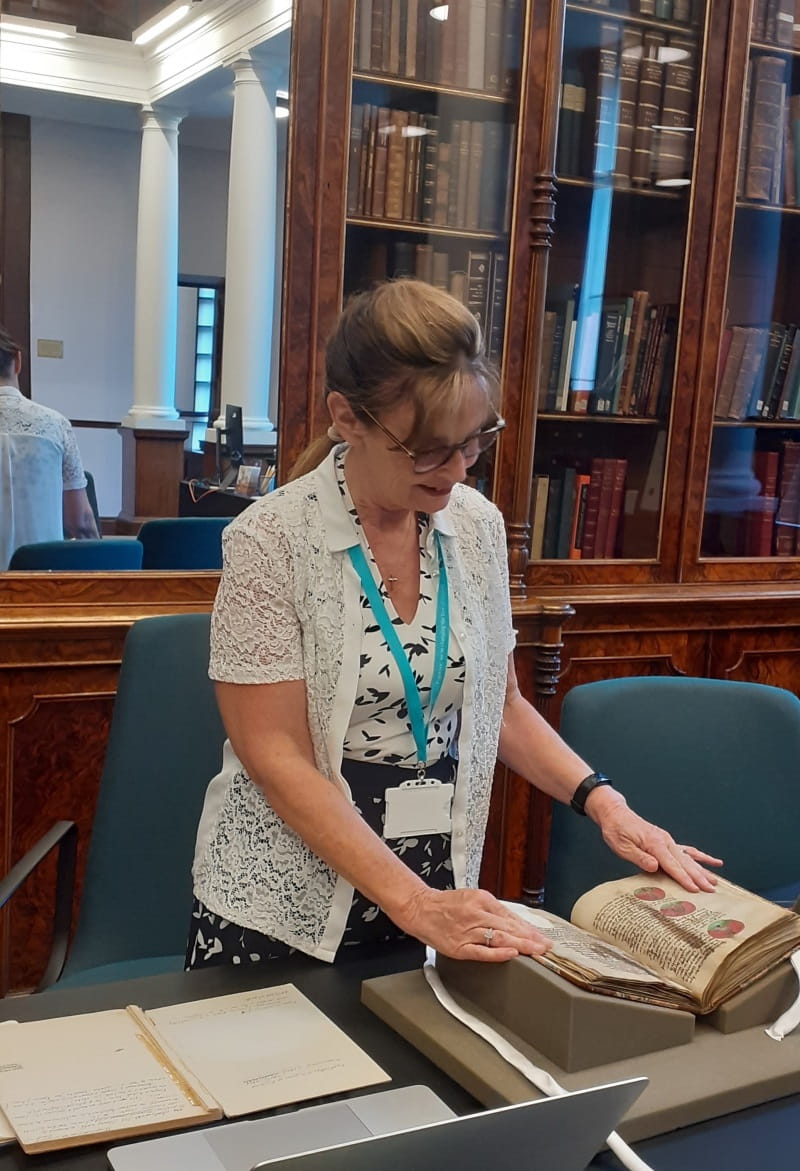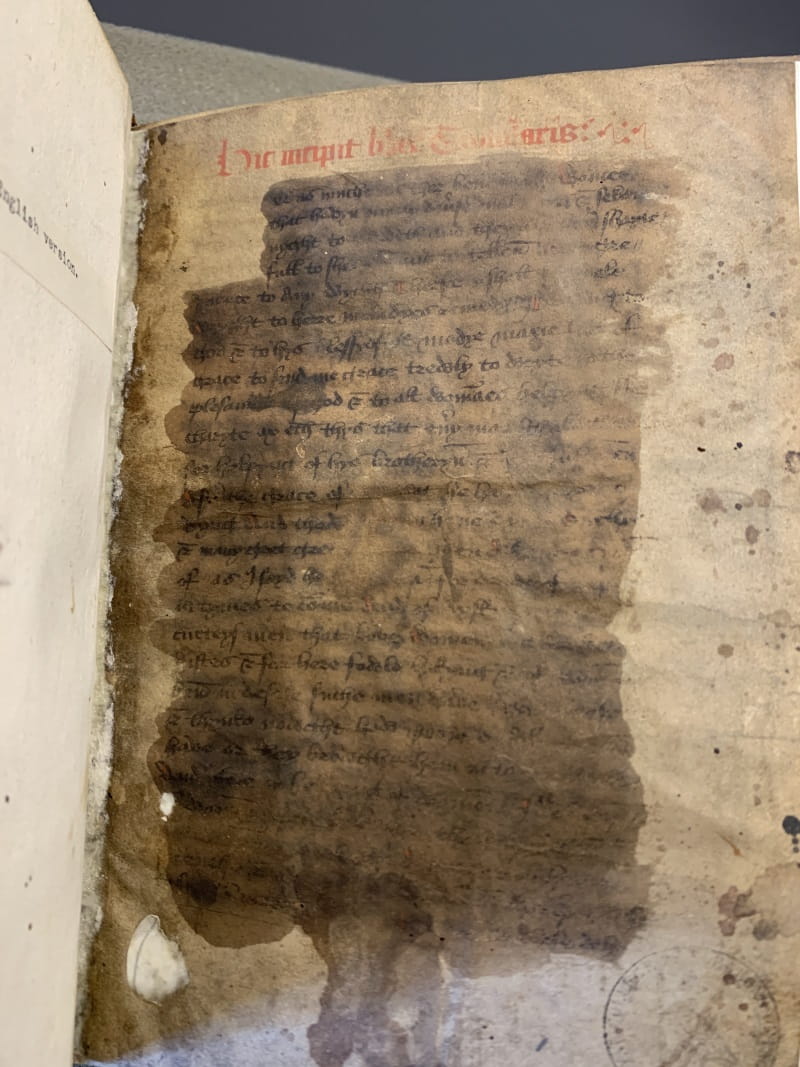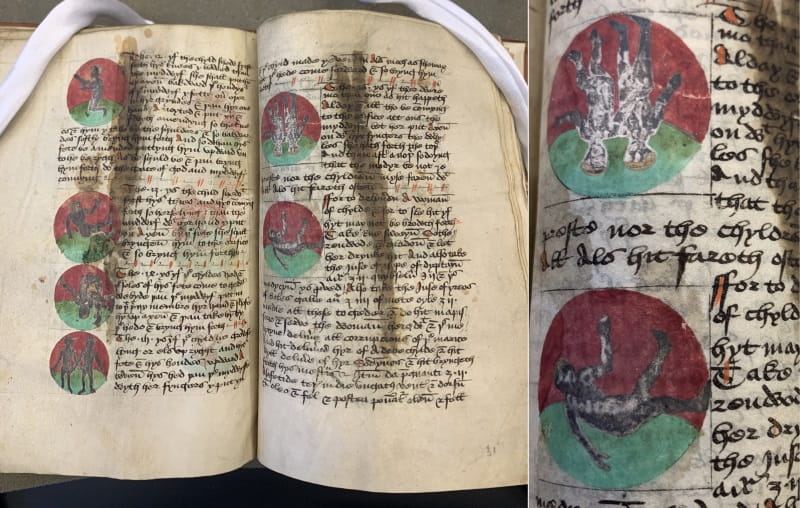The mysteries behind a mediaeval manuscript of "women's ills"
15 Jan 2024
Wendy Suffield
It is rare to find a book among the archive collections of the Royal College of Surgeons of England, but one such treasure is a mediaeval manuscript from the 1450s, a Middle English text that has come to be known as The Sekenesse of Wymmen by Gilbertus Anglicus (MS0175). The core of this work is the obstetric and gynaecological section of his Compendium Medicinae, a medical encyclopedia originally compiled by the author in Latin c. 1250. In the late 14th or early 15th century, the Compendium was translated into Middle English. The chapters on women were recognized to be of such value that they circulated on their own. Then, several decades later, yet another compiler decided to expand the text further, adding new sections and, most stunningly, a set of images. This is one of just four copies of this expanded version known to exist. Just handling this beautifully illustrated manuscript feels like an honour. But it is a manuscript that raises several questions and mysteries.
Above: Wendy Suffield, Henry Lumley Collections Engagement Grant researcher, reading Translation of Gilbertus Anglicus "The Sekenesse of Wymmen" [formerly identified as the "Liber Trotularis"].
What is this book?
The first mystery is that an accompanying notebook from a previous owner of this manuscript, Dr Sam Merriman, shows that he clearly thought it was a different book. This is perhaps not surprising when the first words you read are in Latin, Hic Incipit Liber Trotularis (“Here begins the book of Trotula”). This name refers to a popular and influential compendium of three texts on women’s medicine, one of which is thought to have been written by a medical woman in the 12th century, Trota of Salerno. Given that the first female member of the Royal College of Surgeons of England, Dossibai Patel, was not enrolled until 1910, it can seem surprising to realise that women surgeons were practising and writing textbooks as far back as the twelfth century (and possibly earlier).
The first page of RCS England’s edition, alas heavily damaged. You can just make out Hic incipit Liber Trotularis in red.
The Sickness of Women
However, in 1992 this manuscript was identified by medieval historian Monica H. Green as the work of Gilbertus Anglicus. In 2006, Green and Middle English specialist Linne R. Mooney made the first comprehensive study on the basis of all the extant manuscripts. According to these experts, Gilbertus was in fact drawing on Trota’s work, and the last four chapters are based on the compendium known as the Trotula. However, the authorship is thought to be male, which raises another mystery. At a time when male access to female genitalia, even for medical purposes, was at the time considered tantamount to infidelity, where do the intimate details come from? The text shows intimate access to the female patient’s body that some consider only a female practitioner is likely to have had at the time. This brings us to another confusing question.
Audience
Who was this book aimed at? The opening paragraph of the book declares that it is written for the assistance of women, because they are “ashamed to reveal and tell their distress to any man” (translation: Rowland 1981). Is this, as Rowland thinks, a landmark in women’s attempts to seek comfort and aid from other women, freeing women from dependence on male doctors?
The fact that most of it is not written in Latin suggests that it is aimed at apprenticed surgeons, barber-surgeons, apothecaries and possibly midwives, not at university-trained physicians. The medical details are such that it is unlikely to be aimed at a lay reader. However, contemporary literacy levels amongst women suggest few could have read it. From 1421, efforts were being made to limit the practise of medicine to licensed doctors, to exclude the “greate multitude of ignorant persons” (including women!), which culminated in The Physicians and Surgeons Act 1511. Green and Mooney consider it more likely that this was written to educate men about the diagnosis and treatment of women’s obstetrics and gynaecology. It is possible that it was a deliberate attempt to set boundaries to this specialist knowledge that only men could access. It certainly raises questions about women’s roles in medicine at that time.
Illustrations
Double page spread and close-up of various birth presentations.
This manuscript includes many hand-coloured illustrations showing the delivery of an infant in abnormal presentations, accompanied by detailed instructions to the midwife on how to correct and extract the malpresented foetus. Yet these were usually excluded from medieval medical treatises such as the Book of Trotula. What is fascinating is that the foetus is depicted as a miniature adult man (homunculus): there is no attempt to show foetal development, merely the malpresentations. No foetal positions here!
The mysteries of authorship, readership, and of what women’s medical roles were at this time, ensure that this is a fascinating manuscript to study.
Wendy Suffield, PhD, Henry Lumley Collections Engagement Grant Researcher.
If you found this article interesting you may also enjoy this post: “The Birth of Mankind: Putting the text in context” and this RCS Bulletin article: “Women in the delivery room and the printing house”.
Sources:
Green M.H. “Obstetrical and gynecological texts in Middle English”. Studies in the Age of Chaucer. 1992;14(1):53-88.
Monica H. Green and Linne R. Mooney. “The Sickness of Women”, in Sex, Aging, and Death in a Medieval Medical Compendium: Trinity College Cambridge MS R.14.52, Its Texts, Language, and Scribe, ed. M. Teresa Tavormina, Medieval & Renaissance Texts and Studies, 292, 2 vols. Tempe, AZ: Arizona Center for Medieval and Renaissance Studies. 2006; vol. 2: 455-568. At 459.
Rowland, B. (ed.) Medieval Woman’s Guide to Health: The First English Gynecological Handbook. London: Croom Helm; 1981.



